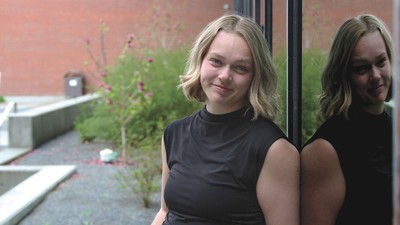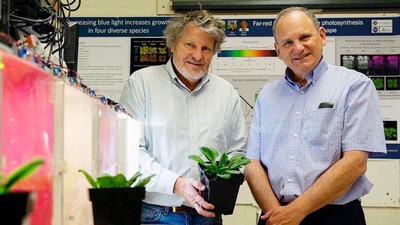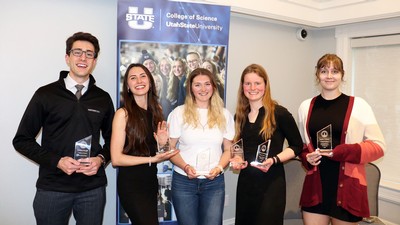Coming to Life: The 'Work' of Art at USU
Artist Mark Pomilio with 'Carbon Blue,' a work he created for the University of Michigan. He envisions a similar approach for the work he’s creating for USU’s Life Sciences Building. Courtesy Mark Pomilio.
What’s your favorite work of art on the USU campus? Is it James Russell’s celebratory Sojourn near Old Main? Or could it be Joseph Kinnebrew’s whimsical SNAFU (better known as “The French Fries”)? Perhaps your sentimental heart has a soft spot for the beloved Block A on the Quad.
Whatever the choice, you likely have memories of a work you found challenging, inspiring or comforting. The Aggie tradition continues with two exciting works commissioned for the new Life Sciences Building.
Artist Mark Pomilio says he’s been preparing himself to create his project, tentatively titled Symbols and Symmetries, “my entire life.”
Fascinated with the complexity of nature since childhood, Pomilio, as a fledgling artist, initially sought to capture landscapes in oil paintings, often using photographs as guides.
“At a certain point, I realized the photograph actually hindered me,” says the associate professor in the School of Art at Arizona State University’s Herberger Institute for Design and the Arts. “When we see a landscape, a tree or a human body, we don’t see individual seeds or cells. We see the culmination of a dynamic process that’s continuing to evolve. It’s a total paradigm shift in perception.”
It was a life-changing revelation for Pomilio, classically trained at the Pennsylvania Academy of Fine Arts in Philadelphia.
“I classify nature’s ever-changing essence as a fourth-dimensional notion, rather than a static, two-dimensional interaction found in drawing and painting,” says the Pennsylvania native. “Expressing the fact that nature, both on a molecular and monumental scale, is in a perpetual state of change became the basis for all of my work.”
Inspired by carbon nanotube research and other endeavors in nanotechnology he witnessed at the University of Michigan, Pomilo created the large-scale commission Carbon Blue for the institution’s Center of Excellence in Nano Mechanical Science and Engineering in 2015. He envisions a unique work for USU that incorporates the multi-planed structure of Carbon Blue.
“There’s an inherent aspect of uncertainty in the outcome of my work,” Pomilio says. “Just as an organism begins with a single cell or a grain of sand begins its journey from mountain to shore, my commission for USU, advancing from a smaller model, will grow and create a complex, but unified, form.”
Expect influence from Utah’s unique geological landscapes, he says.
“Since moving to the western United States in 2006, I attempt to travel to Utah’s canyons two or three times a year, as I find these landscapes some of the most beautiful I’ve ever experienced,” Pomilio says. “Utah has become my muse.”
Water is life: a visceral sentiment shared by residents of the arid West, who anxiously scan the skies and mountaintops year round for signs of, in the folksy Utah vernacular, “moisture.”
Imagining the natural intersection of interests and pursuits for USU’s life scientists, Atlanta-based artist Amy Landesberg quickly hit upon the concept of water.
“But I didn’t want to create merely a representation of water,” she says. “I sought interaction. Something people can experience.”
Short of an actual water feature, how does one manifest water?
Landesberg envisions glass. And her pursuit of how to bring water to life through glass has led her to varied glassmaking studios in the eastern U.S., ultimately finding century-old expertise equal to her task at West Virginia’s renowned Blenko Glass.
Landesberg is creating Surface Tension, a multi-story wall of perpetually beading droplets that will grace the Life Sciences Building atrium.
Capturing just the right “strong in the shoulder,” as she describes the quivering shape of each raindrop, teardrop, dribble, required major study of the fine art, and complicated technology, of glass casting.
“So, basically, to make glass, you need to blow, gather and drop, or ladle,” says Landesberg, revealing a newly acquired vocabulary of an ancient art.
She ruled out blowing, which didn’t yield the desired effect, and determined “gathering and dropping” the molten glass into graphite molds would produce the unique shapes she’d craft into a shimmering surface.
“To my surprise, the molds leave ‘chill marks’ that create a stippled surface – a ‘skin’ that looks like the undulating surface of a body of water,” Landesberg says.
Her work includes an added surprise. A number of the droplets, close to viewers’ eye levels, will hold images – insects, molecular diagrams, graphs and the like – unique to USU’s research.
The colors of the droplets, Landesberg says, will reflect turquoise, blue and deep green – “the colors we tend to hold for water in our imagination.”
“The droplets will capture the colors of the light-filled space,” she says. “I hope they’ll capture the imagination and the passion of the Aggie scholars who’ll begin their academic and career journeys within those walls.”
Related Links
“The ‘Work’ of Art,” Discovery magazine, Spring 2018
Coming to Life: The Campaign to Build USU’s Life Sciences Building
USU College of Science
Contact: Patrick Svedin, 801-946-0551, patrick.svedin@usu.edu
Writer: Mary-Ann Muffoletto, 435-797-3517, maryann.muffoletto@usu.edu
Close-up rendering of glass 'droplets' artist Amy Landesberg is creating for her two-story work, ‘Surface Tension,’ for USU’s Life Sciences Building. Courtesy Amy Landesberg.
TOPICS
Design 84storiesComments and questions regarding this article may be directed to the contact person listed on this page.








